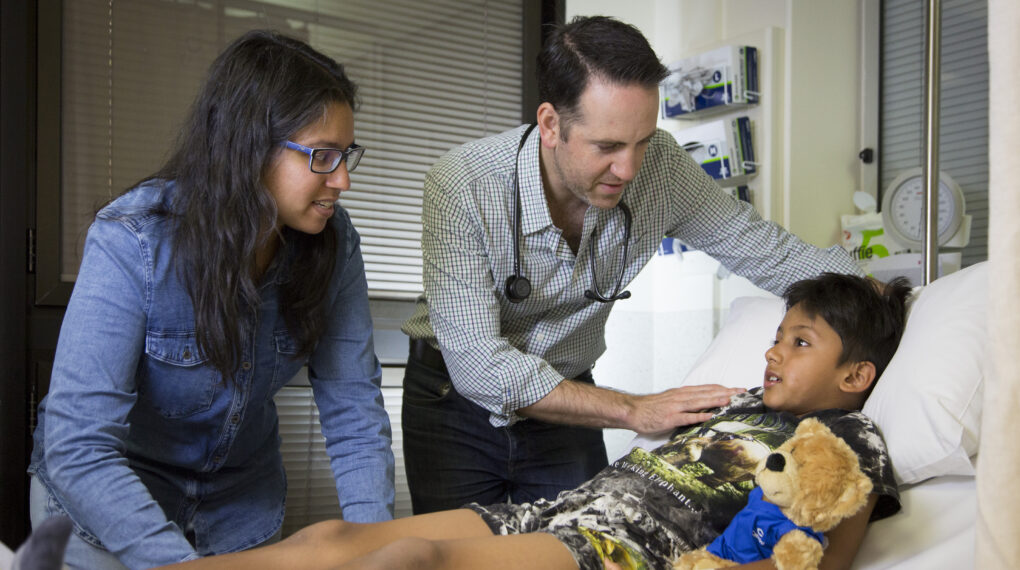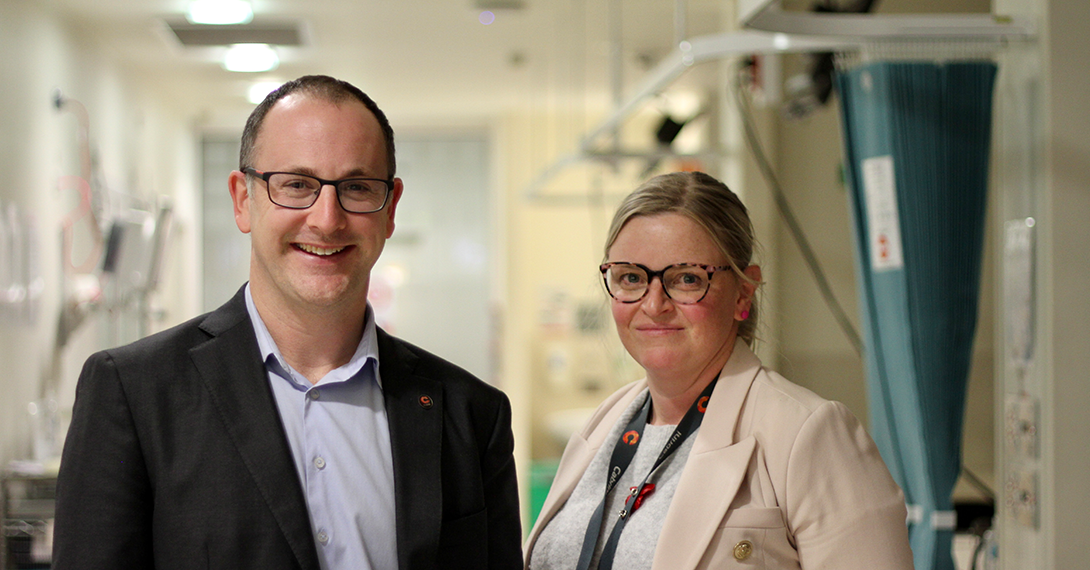About the emergency medicine research department
The Cabrini emergency medicine research department is interested in novel and innovative approaches to improve the care we provide our community. Our focus for emergency medicine research is looking at novel strategies to emergency medicine care which can enhance the patient experience for those receiving treatment within our emergency department (ED).
We are interested in collaborating with universities and other health services to implement improvements which can positively affect the experience, safety and efficiency of attending an ED. Our research programs include exploring the use of My Health Record in the ED, the value and efficacy of follow up calls post an emergency department visit, body worn sensors development, and interactive screens in the ED waiting room.
Team members
- MRFF Monash Partners, Critical Care, rapid translational research flagship program. ‘Emergency medicine wait time visibility’. (2019-2021), $250,000 Walker K (CI), Joe K, Ben-Meir M.
- MRFF Monash Partners. ‘Be your best: an innovative co-designed approach to frailty and care-transitions from hospital to home, in people aged 65 years or more’. (2019-2021), $198,000 Lowthian J (CI), Boyd L (AI), Rose M (AI), Walker K (AI) et al.
- Cabrini Auric grant. ‘Developing and testing virtual reality tools to reduce agitation in cognitively impaired older people in emergency departments’. (2019-2021), $147,000 Blecher (CI), Walker K (AI) et al.
- Cabrini Improvement Research Grant. ‘My Health Record in the emergency department: An investigation of adoption, utilisation and utility’ (2020-2021), $15,000 Mullins A (CI), Ben-Meir M, Rankin D, Skouteris H.
- Ben‐Meir M. (2021) Private emergency medicine: A perspective. Emergency Medicine Australasia. 33(1):145-6. doi:10.1111/1742-6723.13709.
- Bertenshaw C, Dubash R, Kozlovski J, Ho JH. (2020) Pre-hospital and retrieval medicine: Special skills placements and subspecialty training. Emergency Medicine Australasia: EMA. 32(4):667-9. doi:10.1111/1742-6723.13577.
- Brichko L, Gaddam R, Roman C, O’Reilly G, Luckhoff C, Jennings P, Smit DV, Cameron P, Mitra B. (2021) Rapid administration of methoxyflurane to patients in the emergency department (RAMPED) study: a randomised controlled trial of methoxyflurane versus standard care. Academic Emergency Medicine. 28(2):164-71. doi:org/10.1111/acem.14144.
- Buchbinder R, Bourne A, Staples M, Lui C, Walker K, Ben‐Meir M, Gorelik A, Blecher G. (2021) Management of patients presenting with low back pain to a private hospital emergency department in Melbourne, Australia. Emergency Medicine Australasia. doi:10.1111/1742-6723.13814.
- Dubash R, Bertenshaw C, Ho JH. (2020) Decision fatigue in the emergency department. Emergency Medicine Australasia: EMA. 32(6):1059-1061. doi:10.1111/1742-6723.13670.
- Ho JH, Kozlovski J. (2020) Private parts: Emergency medicine in the private sector. Emergency Medicine Australasia: EMA. 33(1):142-144. doi:10.1111/1742-6723.13708.
- Jones P, Haustead D, Walker K, Honan B, Gangathimmaiah V, Mitchell R, Bissett I, Forero R, Martini E, Mountain D. (2021) Has the implementation of time‐based targets for emergency department length of stay influenced the quality of care for patients? A systematic review of quantitative literature. Emergency Medicine Australasia. doi:10.1111/1742-6723.13760.
- Kozlovski J, Carlin E, Ho JH, Dubash R. (2020) ‘She looks sick’: Heuristics and cognitive bias in emergency medicine. Emergency Medicine Australasia. 32(5):847-8. doi:10.1111/1742-6723.13627.
- Kozlovski J, Matthews A, Bertenshaw C, Ho JH. (2021) Do we do enough paediatrics? Emergency Medicine Australasia: EMA. 33(4):734-736. doi:10.1111/1742-6723.13822.
- Lim A, Gupta N, Lim A, Hong W, Walker K. (2020) Description of the effect of patient flow, junior doctor supervision and pandemic preparation on the ability of emergency physicians to provide direct patient care. Australian Health Review. 44(5):741-747. doi:10.1071/AH20180.
- Lowthian JA, Green M, Meyer C, Cyarto E, Robinson E, Mills A, Sutherland F, Hutchinson AM, Smit DV, Boyd L, Walker K. (2021) Protocol: Being Your Best: protocol for a feasibility study of a codesigned approach to reduce symptoms of frailty in people aged 65 years or more after transition from hospital. BMJ Open. 11(3):e043223. doi:10.1136/bmjopen-2020-043223.
- Mullins A, O’Donnell R, Mousa M, Rankin D, Ben-Meir M, Boyd-Skinner C, Skouteris H. (2020) Health outcomes and healthcare efficiencies associated with the use of electronic health records in hospital emergency departments: A systematic review. Journal of Medical Systems. 44(12):200. doi:10.1007/s10916-020-01660-0.
- Mullins AK, Morris H, Bailey C, Ben-Meir M, Rankin D, Mousa M, Skouteris H. (2021) Physicians’ and pharmacists’ use of My Health Record in the emergency department: Results from a mixed-methods study. Health information science and systems. 9(1):19. doi:10.1007/s13755-021-00148-6.
- O’Reilly GM, Mitchell RD, Wu J, Rajiv P, Bannon‐Murphy H, Amos T, Brichko L, Brennecke H, Noonan MP, Mitra B, Paton A. (2020) Epidemiology and clinical features of emergency department patients with suspected COVID‐19: Results from the first month of the COVID‐19 Emergency Department Quality Improvement Project (COVED‐2). Emergency Medicine Australasia. 32(5):814-822. doi:10.1111/1742-6723.13573.
- O’Reilly GM, Mitchell RD, Mitra B, Noonan MP, Hiller R, Brichko L, Luckhoff C, Paton A, Smit DV, Cameron PA. (2020) Impact of patient isolation on emergency department length of stay: A retrospective cohort study using the Registry for Emergency Care. Emergency Medicine Australasia. 32(6):1034-1039. doi:10.1111/1742-6723.13607.
- Tsao H, Ho JH. (2021) Frequent attenders in the emergency department: A trainee perspective. Emergency Medicine Australasia: EMA. doi:10.1111/1742-6723.13786.
- Walker K, Wu E, Yip B, Stephenson M, Loupis A. (2020) What emergency department wait times do community members want to see displayed? Emergency Medicine Australasia. 33(1):181-183. doi:10.1111/1742-6723.13696.
- Walker K, Honan B, Haustead D, Mountain D, Gangathimmaiah V, Forero R, Mitchell R, Martini E, Tesch G, Bissett I, Jones P. (2021) Have emergency department time‐based targets influenced patient care? A systematic review of qualitative literature. Emergency Medicine Australasia. 33(2):202-213. doi:10.1111/1742-6723.13747.
- Walker KJ, Jiarpakdee J, Loupis A, Tantithamthavorn C, Joe K, Ben-Meir M, Akhlaghi H, Hutton J, Wang W, Stephenson M, Blecher G. (2021) Predicting ambulance patient wait times: A multicenter derivation and validation study. Annals of Emergency Medicine. 78(1):113-122. doi:10.1016/j.annemergmed.2021.02.010.
- Walker K, Stephenson M, Loupis A, Ben‐Meir M, Joe K, Stephenson M, Lowthian J, Yip B, Wu E, Hansen K, Rosler R. (2021) Displaying emergency patient estimated wait times: A multicentre, qualitative study of patient, community, paramedic and health administrator perspectives. Emergency Medicine Australasia. doi:10.1111/1742-6723.13640.
- Walker K, Dwyer T, Heaton HA. (2021) Emergency medicine electronic health record usability: where to from here? Emerg Med J. 38(6):408-409. doi:10.1136/emermed-2021-211384.
- Walker K, Heaton HA. (2021) The evidence base for scribes and the disruptions of COVID-19. Ann Emerg Med. 77(2):190-192. doi:10.1016/j.annemergmed.2020.09.438.
- Walker K, Yu K, Choong ZS, Loupis A, Richardson G. (2021) Routine antibiotics in the febrile cancer patient: should immune checkpoint inhibitors affect our practice? Emerg Med J. 38(1):85-86. doi:10.1136/emermed-2020-210224.
New discoveries and research focus
Exploring the use of Australia’s national Electronic Health Record (MHR) in the emergency department
As the first published peer reviewed paper to examine how the MHR has been adopted by on the ground users, it has shown that MHR use in the ED is currently lower than anticipated, and there is a great opportunity to improve use both across the ED and the broader healthcare system. The paper highlights the urgent need to improve use, improve training, and raise awareness as well as the great benefit in using the MHR system in the fast paced ED—including saving time for patients and clinicians, reducing the number of tests performed, and improving patient care and patient outcomes.

